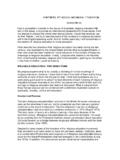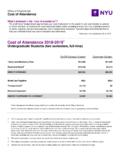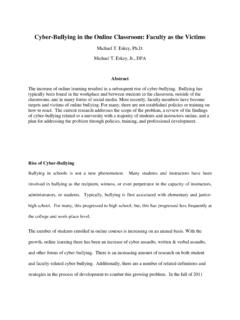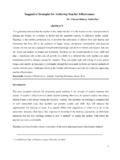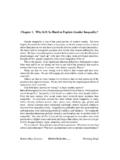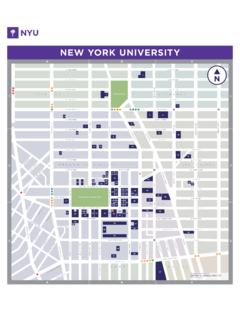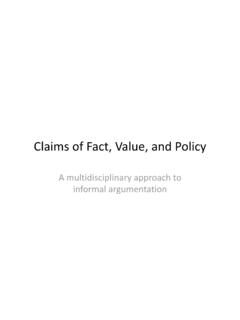Transcription of Music Classification - nyu.edu
1 Music ClassificationJuan Pablo BelloMPATE-GE 2623 Music Information RetrievalNew York University1 Classification It is the process by which we automatically assign an individual item to one of a number of categories or classes, based on its characteristics. In our case: (1) the items are audio signals ( sounds, songs, excerpts); (2) their characteristics are the features we extract from them (MFCC, chroma, centroid); (3) the classes ( instruments, genres, chords) fit the problem definition The complexity lies in finding an appropriate relationship between features and classes2 Example 200 sounds of 2 different kinds (red and blue); 2 features extracted per sound3 The 200 items in the 2-D feature space Example4 Boundary that optimizes performance -> risk of overfitting (excessive complexity, poor predictive power)Example5 Generalization -> Able to correctly classify novel inputExample6 Classification of Music signals A number of relevant MIR tasks: Music Instrument Identification Artist ID Genre Classification Music /Speech Segmentation Music Emotion Recognition Transcription of percussive instruments Chord recognition Re-purposing of machine learning methods that have been successfully used in related fields ( speech, image processing)7A Music classifier Feature extraction: (1) feature computation.
2 (2) summarization Pre-processing: (1) normalization; (2) feature selection Classification: (1) use sample data to estimate boundaries, distributions or class-membership; (2) classify new data based on these estimationsFeature vector 1 Feature vector 2 Classification Model 8 Feature set (recap) Feature extraction is necessary as audio signals carry too much redundant and/or irrelevant information They can be estimated on a frame by frame basis or within segments, sounds or songs. Many possible features: spectral, temporal, pitch-based, etc. A good feature set is a must for classification What should we look for in a feature set?9 Feature set (what to look for?) A few issues of feature design/choice: (1) can be robustly estimated from audio ( spectral envelope vs onset rise times in polyphonies) (2) relevant to classification task ( MFCC vs chroma for instrument ID) -> noisy features make classification more difficult!
3 Classes are never fully described by a point in the feature space but by the distribution of a sample population 10 Features and training Class models must be learned on many sounds/songs to properly account for between/within class variations The natural range of features must be well represented on the sample population Failure to do so leads to overfitting: training data only covers a sub-region of its natural range and class models are inadequate for new set (what to look for?) We expect variability within sound classes For example: trumpet sounds change considerably between, different loudness levels, pitches, instruments, playing style or recording conditions (3) feature set should be as invariant as possible to those changes12 Feature set (what to look for?)
4 (4) low(er) dimensional feature space -> Classification becomes more difficult as the dimensionality of the feature space increases. (5) as free from redundancies (strongly correlated features) as possible (6) discriminative power: good features result in separation between classes and grouping within classes13 Feature distribution Remember the histograms of our example. They describe the behavior of features across our sample population. It is desirable to parameterize this behavior14 A Normal or Gaussian distribution is a bell-shaped probability density function defined by two parameters, its mean ( ) and variance ( 2):N(xl; , )=1 2 e (xl )22 2 Feature distribution =1LL l=1xl 2=1LL l=1(xl )215 In D-dimensions, the distribution becomes an ellipsoid defined by a D-dimensional mean vector and a DxD covariance matrix: Feature distributionCx=1LL l=1(xl )(xl )T16 Cx is a square symmetric DxD matrix: diagonal components are the feature variances.
5 Off-diagonal terms are their co-variances High covariance between features shows as a narrow ellipsoid (high redundancy)Feature distribution*from Shlens, 200917 To avoid bias towards features with wider range, we can normalize all to have zero mean and unit variance:Data normalization! "=1! =0 x=(x )/ 18 Complementarily we can minimize redundancies by applying Principal Component Analysis (PCA) Let us assume that there is a linear transformation A, such that: Where xl are the D-dimensional feature vectors (after mean removal) such that: Cx = XXT/LPCAY=AX a1 x1 a1 x1 aD xL = [x1x2 xL]19 PCA What do we want from Y: Decorrelated: All off-diagonal elements of Cy should be zero Rank-ordered: according to variance Unit variance A -> orthonormal matrix; rows = principal components of X20 PCA How to choose A?
6 Any symmetric matrix (such as Cx) is diagonalized by an orthogonal matrix E of its eigenvectors For a linear transformation Z, an eigenvector ei is any non-zero vector that satisfies: Where i is a scalar known as the eigenvalue PCA chooses A = ET, a matrix where each row is an eigenvector of Cx Cy=1 LYYT=1L(AX)(AX)T=A(1 LXXT)AT=ACxATZei= iei21 PCA In MATLAB:From ~shlens/pub/ 22 dimensionality reduction Furthermore, PCA can be used to reduce the number of features: Since A is ordered according to eigenvalue i from high to low We can then use an MxD subset of this reordered matrix for PCA, such that the result corresponds to an approximation using the M most relevant feature vectors This is equivalent to projecting the data into the few directions that maximize variance We do not need to choose between correlating (redundant) features, PCA chooses for us.
7 Can be used, , to visualize high-dimensional spaces23 Discrimination Let us define:Sw=K k=1(Lk/L)CkSb=K k=1(Lk/L)( k )( k )TProportion of occurrences of class k in the sampleWithin-class scatter matrixCovariance matrix for class kBetween-class scatter matrixglobal meanMean of class k24 Discrimination Trace{U} is the sum of all diagonal elements of U, : Trace{Sw} measures average variance of features across all classes Trace{Sb} measures average distance between class means and global mean across all classes The discriminative power of a feature set can be measured as: High when samples from a class are well clustered around their mean (small trace{Sw}), and/or when different classes are well separated (large trace{Sb}).
8 J0=trace{Sb}trace{Sw}25 Feature selection But how to select an optimal subset of M features from our D-dimensional space that maximizes class separability? We can try all possible M-long feature combinations and select the one that maximizes J0 (or any other class separability measure) In practice this is unfeasible as there are too many possible combinations We need either a technique to scan through a subset of possible combinations, or a transformation that re-arranges features according to their discriminative properties26 Feature selection Sequential backward selection (SBS):1. Start with F = D For each combination of F-1 features compute J03. Select the combination that maximizes J04. Repeat steps 2 and 3 until F = M Good for eliminating bad features; nothing guarantees that the optimal (F-1)-dimensional vector has to originate from the optimal F-dimensional one.
9 Nesting: once a feature has been discarded it cannot be reconsidered27 Feature selection Sequential forward selection (SFS):1. Select the individual feature (F = 1) that maximizes J02. Create all combinations of F+1 features including the previous winner and compute J03. Select the combination that maximizes J04. Repeat steps 2 and 3 until F = M Nesting: once a feature has been selected it cannot be discarded28 LDA An alternative way to select features with high discriminative power is to use linear discriminant analysis (LDA) LDA is similar to PCA, but the eigenanalysis is performed on the matrix Sw-1Sb instead of Cx Like in PCA, the transformation matrix A is re-ordered according to the eigenvalues i from high to low Then we can use only the top M rows of A, where M < rank of Sw-1Sb LDA projects the data into a few directions maximizing class separability29 Classification We have: A taxonomy of classes A representative sample of the signals to be classified An optimal set of features Goals.
10 Learn class models from the data Classify new instances using these models Strategies: Supervised: models learned by example Unsupervised: models are uncovered from unlabeled data30 Instance-based learning Simple classification can be performed by measuring the distance between instances. Nearest-neighbor classification: Measures distance between new sample and all samples in the training set Selects the class of the closest training sample k-nearest neighbors (k-NN) classifier: Measures distance between new sample and all samples in the training set Identifies the k nearest neighbors Selects the class that was more often learning In both these cases, training is reduced to storing the labeled training instances for comparison Known as lazy or memory-based learning.
